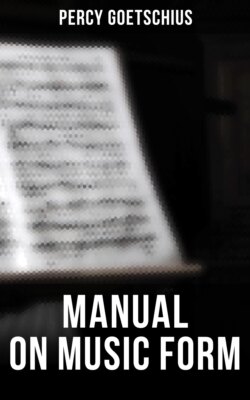Читать книгу Manual on Music Form - Percy Goetschius - Страница 14
На сайте Литреса книга снята с продажи.
[Illustration: Example 5. Fragment of Beethoven.]
ОглавлениеTable of Contents
The tones bracketed a, if struck all together, unite and blend in one harmonious body, so complete is the harmonic agreement of each succeeding tone with its fellows; the same is true of the group marked c. The tones bracketed b and d do not admit of being struck simultaneously, it is true, but they are all parts of the same key (F minor), and are closely and smoothly connected; hence their concurrence, though not one of harmony (chord), is one of intimate tone relation and proximity. Further, the whole group marked 2 corresponds in its linear formation, its rising, poising and curling, exactly to the preceding group, marked 1. This, then, is a good melody—tuneful, interesting, intelligible, striking and absolutely definite.
In the second place, the tones and groups in a good melody are measured with reference to harmony of time-values; that is, their metric condition, and their rhythmic arrangement, corroborate the natural laws already defined:—uniformity of fundamental pulse, uniform recurrence of accent, and sufficient regularity of rhythmic figure to insure a distinct and comprehensible total impression. This also may be verified in the time-values of Ex. 5. Scrutinize also, the melodic and rhythmic conditions of Exs. 1 and 2—and the examples on later pages—and endeavor to vindicate their classification as "good" melodies. Ex. 4, though an exposition of irregular rhythm, is none the less excellent on that account; on the contrary, this irregularity, because wisely balanced by sufficient evidence of harmonious and logical agreement, only heightens the beauty and effectiveness of the melody.
Whenever whole bodies of tone are played successively, a number of melody lines are being described—as many, in fact, as there are tones in each body. For example, in playing a hymn-tune we describe (on the keyboard) the four separate melodies known as the soprano, alto, tenor and bass voices. In a duet, unaccompanied, there are two melodic lines; if accompanied, other melodic lines are added to these. Thus we recognize the same system of associated lines in music as in architecture or drawing. Very rarely indeed does one single unbroken line portray a complete image.
But in music, as in drawing, the lines differ in their degrees of importance and prominence; and, very commonly, one line over-shadows all, or nearly all the rest. This strongest tone-line is therefore apt to be designated, somewhat unfairly, the melody (the "tune" or "air" is more just). But, at all events, this predominating melodic line is the most important factor of the form, the one upon which the definition and recognition of the "form" depend; and it is therefore necessary that the student learn to distinguish it, to acquire the habit of centring his attention upon it—in reading, listening to, or analyzing music; and, in playing, to give it the emphasis it requires.
The importance of a tone-line depends solely upon its conspicuousness. The principal melody—the Melody—is the one which is most salient, which most attracts the hearer's attention. For this reason the composer is induced to place his chief melody above the rest of the tone-lines, because the uppermost tone strikes the ear more acutely than the lower ones, and therefore the succession of highest tones constitutes a conspicuous line that attracts and impresses the sense most keenly.
Here then, at the top of the harmonic tone-complex, we look for the chief melody; and here it will be found—excepting when arbitrary emphasis (by accentuation) is imparted to some lower tone-line, so that it, for the time being, assumes a prominence equal, or superior, to that of the uppermost line. (This divided prominence is seen in the 18th Song Without Words—the duet.)
LESSON 2.—Write careful and complete answers to the following questions:—
1. What is Time, as applied to music?
2. What is tempo?
3. Give a full definition of the beat.
4. By what time-value is it most commonly indicated?
5. Give a full definition of the measure.
6. Why do measures differ in size?
7. What is a simple measure?
8. What is a compound measure?
9. Define duple and triple rhythms. (See also Chap. I.)
10. What does the term rhythm signify?
11. How is it applied in music?
12. When is the rhythm regular?
13. When is the rhythm irregular?
14. Define the difference between melody and harmony.
15. Give a full definition of melody.
16. What are the conditions of a good melody?
17. In what respect does music resemble architecture or drawing?
18. Are the tone-lines in a composition of equal importance?
19. What significance is to be attached to the principal tone-line?
20. Upon what does the importance of a tone-line depend?
21. Where is the chief melody usually placed?
